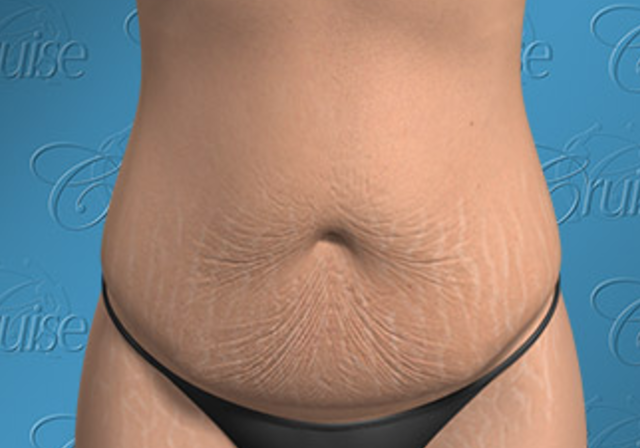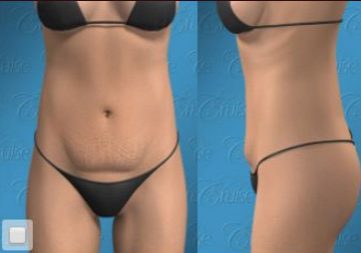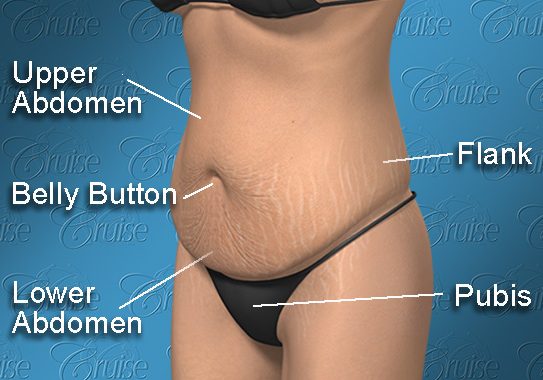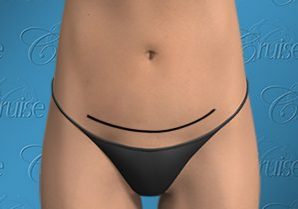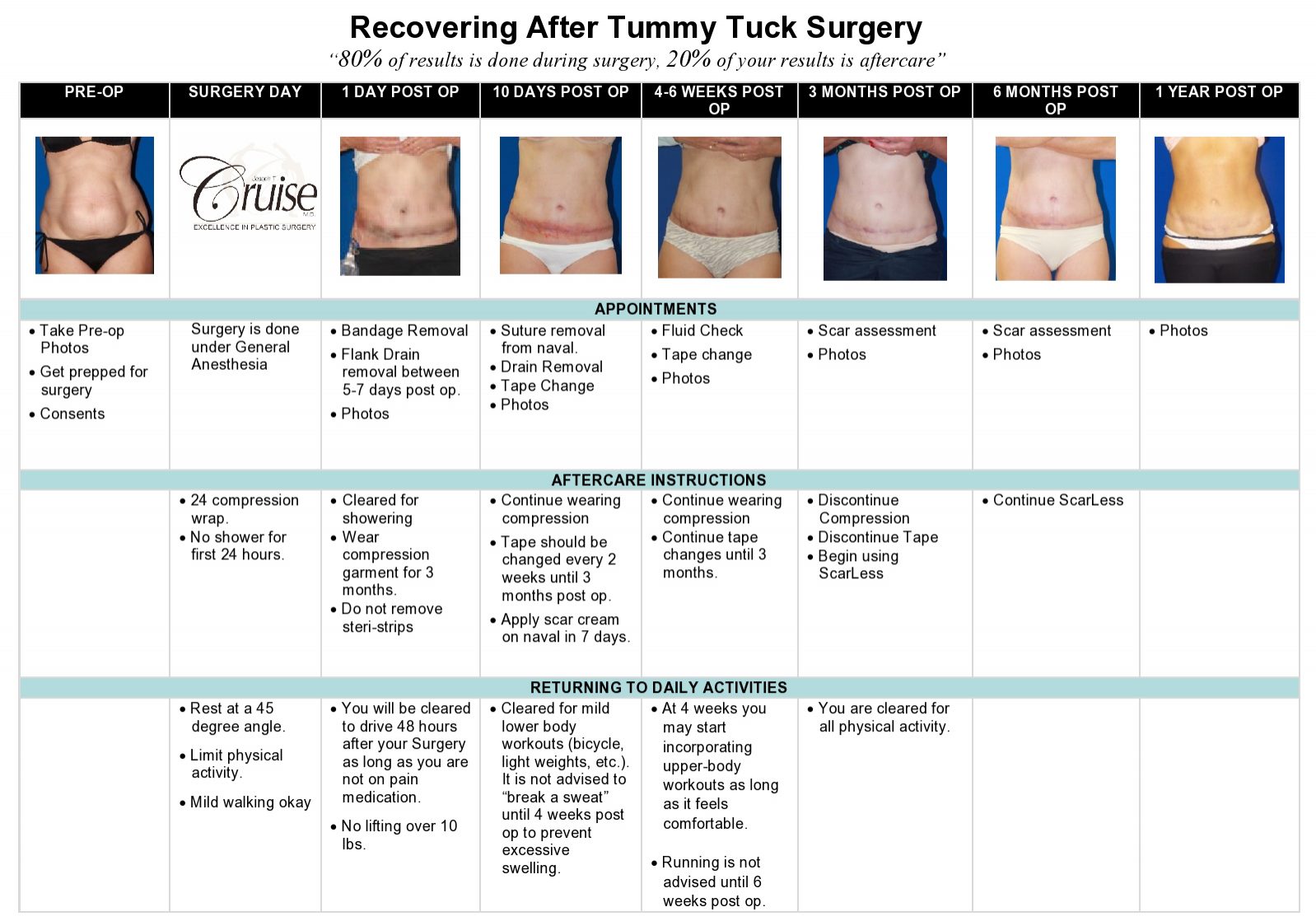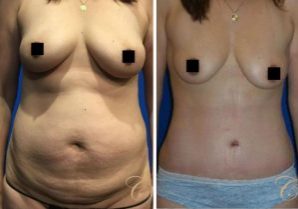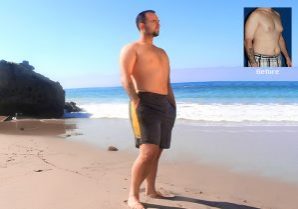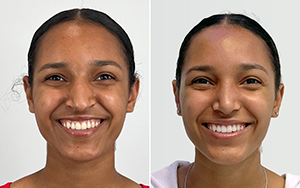Consultation
Tummy Tuck Consultation and Physical Exam
We have outlined below what you can expect from your abdominoplasty consultation with Joseph T Cruise, MD. Read carefully, as there are many suggestions that will save you time, clear up questions, and help you convey what you want to accomplish. You will also learn about the 4 types of tummy tucks Joseph T Cruise, MD performs at his Newport Beach practice.
Health History
All cosmetic surgery consultations begin with a thorough health history. This is especially true if general anesthesia is being used, but also applies to local anesthesia. Abdominoplasties are almost always done under general anesthesia because of the extensive amount of tissue undermining necessary. For this reason it is especially important that your health is optimized. Prior to meeting with Joseph T Cruise, MD you will be given a health history questionnaire to fill out in the waiting area. There are five areas of your health you will be asked about. Be sure to answer in detail, so Joseph T Cruise, MD and the anesthesiologist can optimize their care for you.
General Health
General health problems are important to discuss so that your surgery is as safe as possible. Be sure to mention any chronic illness. Of particular concern are high blood pressure, diabetes, heart problems, liver and kidney disease, stroke, cancer, bleeding issues, and wound healing problems.
What will Joseph T Cruise, MD do if I have medical problems?
In short, he will make sure your health is optimized as much as possible to ensure your safety. This may mean referring you to your private physician.
If you have a health problem you can often save yourself time by getting a letter from your private physician prior to your cosmetic consultation stating what the health problem is, how it is being treated, and whether or not you are able to tolerate general anesthesia safely.
If you are seeing any specialist (cardiologist, kidney doctor, psychiatrist, etc. ) be sure to bring a letter from them stating you are able to tolerate surgery.
Be sure to let Joseph T Cruise, MD know if you have ever had a blood clot. Abdominoplasties have a higher incidence of causing blood clots compared to any other cosmetic procedure.
Past Surgical History
On your questionnaire you will be asked about previous surgeries. Be sure to identify any problems you may have had with anesthesia. Of particular concern are previous cosmetic surgeries, especially if you do not like the result and are interested in revision. With abdominoplasty it is especially important to mention all abdominal surgeries including C-section, gall bladder, and hernia operations.
Medications
Be sure to list all medications you take including aspirin and over-the-counter medications. These are important as they may increase bleeding and affect your surgery. It is extremely important to stop taking aspirin and aspirin containing products at least 2 weeks before surgery. Tylenol is a good alternative. Here is a partial list of aspirin containing products and other products to be avoided prior to surgery.
Allergies to Medications
Information about medications that cause allergies is very important so that these medications can be avoided. Of particular importance is the reaction you had, especially if you had trouble breathing. Be sure to include this information! Nausea is not an allergy but it is important to mention as well.
Smoking, Drinking and Drug Use
These will certainly affect your surgery and MUST be mentioned so that your surgery can be optimized. Smoking causes a profound decrease in wound healing and will lead to worse scarring and a less favorable result. With large procedures such as a face lift, neck lift, tummy tuck, and breast lift, smoking must be stopped at least 6 weeks before and after surgery. Otherwise, the results could be disastrous leading to non-healing wounds, poor scarring, and/or infection. With smaller procedures such as eyelid surgery, nose surgery, breast augmentation, and liposuction, smoking will hurt the overall result but this may or may not be noticeable. In this case smoking cessation is strongly advised but is not mandatory.
Specific Abdominal Issues
During your consultation you must be very accurate with abdominal problems. Of particular concern is a history of abdominal hernia. This problem must be addressed during your consultation. If a hernia is present it can often be fixed during the surgery or if it is large it may need to be fixed with the help of a general surgeon. Another issue that complicates abdominoplasty is previous abdominal surgery. The scars may affect the blood supply of the skin. Once again, any history of blood clot must be discussed.
Physical Exam
The key to the abdominal physical exam is to determine exactly what is causing the problem. Some problems can be treated with liposuction while others require a tummy tuck. Sometimes a combination of the two is best. This section will help you decide what is best for you. Abdominal cosmetic surgery can be broken down into the following 5 categories: liposuction alone, mini-abdominoplasty, standard abdominoplasty, extended abdominoplasty and circumferential abdominoplasty.
Liposuction
Liposuction alone is excellent when skin excess is not a problem and there is a localized excess fat deposit. Liposuction requires that the patient's skin has the ability to shrink back once the fat is removed. Patients with poor skin quality, demonstrated by many stretch marks and cellulite are not good candidates for liposuction. This is better discussed under the liposuction section. Often, patients convince themselves that 'If I could just suck this fat out then my stomach would be flat'. This may be true, but if they have a lot of excess skin or their skin quality is poor then they will be disappointed. Liposuction may leave them with loose, hanging skin often with waviness.
If there is a significant amount of excess skin then the only way to get rid of it is to cut it out via a tummy tuck. Frequently, non-plastic surgeons will perform liposuction and these patients end up with disappointing results. The scars caused by a tummy tuck are very long but this is almost never a complaint. Satisfaction is uniformly high. Once it has been decided that skin excision is necessary the next question is how far to the back should the excision go. The answer is relatively straightforward.
Mini Abdominoplasty (Mini Tummy Tuck)
If your problem is limited to a small amount of loose skin and excess fat below the belly button then a 'mini-abdominoplasty' may be all that is necessary. As the name implies, a mini-abdominoplasty creates a smaller scar. The tradeoff, however, is that it may not obtain the results you are looking for. Generally, if you can only pinch an inch or two then this will probably suffice. The incision stays inside the hip bones and the belly button is not transplanted like in a standard abdominoplasty. It is merely pulled downward toward the pubis. Abdominal muscle tightening is performed up to the level of the umbilicus. This markedly improves the abdominal pooch.
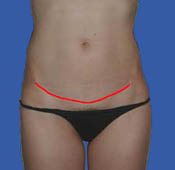 |
|
| Mini Abdominoplasty Incision. | |
Standard Abdominoplasty (Standard Tummy Tuck)
If there is more than an inch or two of excess skin then a standard abdominoplasty is probably necessary. This does an excellent job of removing loose skin, excess fat, and creating a flat stomach. It also helps to create a curvy waist but not as dramatically as an extended abdominoplasty does.
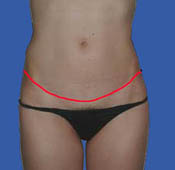 |
|
| Standard Abdominoplasty Incision. | |
Keep in mind, it takes 1-2 years for an abdominoplasty scar to soften and lighten. Joseph T Cruise, MD uses a topical combination of Silicone, Vitamin E, and Steroid to minimize scarring.
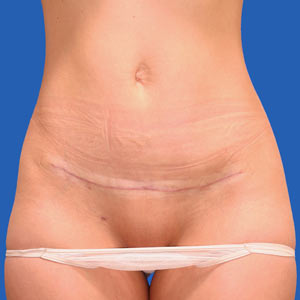 |
|
| Actual After picture with incision exposed.
Typical scar after an Abdominoplasty. Your scar may vary. Some become almost undetectable, other may form thicker, more noticeable scars. |
|
Extended Abdominoplasty (Extended Tummy Tuck)
When the redundant skin goes around toward the back, then there is no other way to remove it but to extend the excision to include this area. This can be identified by grasping the skin over the lateral waist and around to the flanks. Extending the excision to include this skin and fat does a spectacular job of creating an “hour-glass' figure. In doing so, the waist becomes much smaller. This makes the buttocks appear much more attractive and curvy. Furthermore, the breasts appear larger. The reason for this is that the waist is the focal point of the body around which everything else is evaluated. A smaller waist significantly impacts both the breasts and buttocks.
The down side of the extended abdominoplasty is the additional operating time necessary, the additional cost, and of course the longer scar.
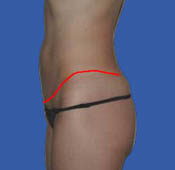 |
| Extended abdominoplasty incision. |
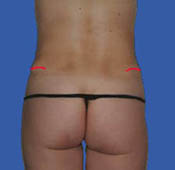 |
| Extended abdominoplasty incision from behind. |
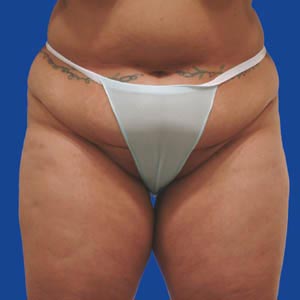
Before
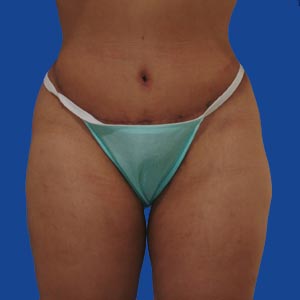
After
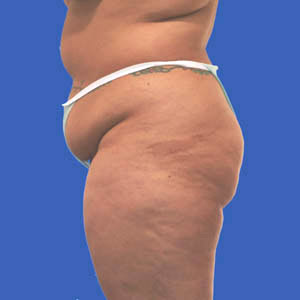
Before
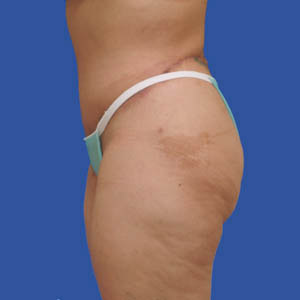
After
Frontal view of extended abdominoplasty.Lateral view of extended abdominoplasty.
Circumferential Abdominoplasty (Body Lift)
As its name implies, this goes completely around the body. This procedure is commonly performed in patients who have lost massive (greater than 100 lbs) amounts of weight. This is not uncommon with patients who had gastric bypass surgery and are left with a significant amount of hanging skin that goes completely around the body. Another name for this procedure is a body lift. This is useful to lift the buttocks and thigh skin back up into an attractive position.
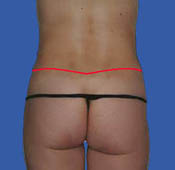 |
|
Circumferential body lift incision |
|
Components of Abdominoplasty:
Skin Excision
In general, you can expect the scar to extend from hip to hip. The scars do not fade until about 6 months and will always remain visible. Hydrocortisone 1% cream does a good job of limiting the redness. The good news is that the scar can easily be hidden by underwear or a bikini; patients rarely complain about it. The trade off is more than worth it. Another big advantage with skin excision is that the stretch marks located below the belly button will be gone forever! The better quality skin located above the belly button is brought down in its place.
Abdominal Muscle Tightening
Often, with age, weight gain, or pregnancy, the stomach muscles separate in the midline causing a diastases. This leads to additional bulging. Therefore, muscle tightening is very helpful in obtaining a desirable, flat stomach. The stomach muscles are tightened during the procedure by suturing them together in the midline.
Belly Button Transposition
It is usually necessary to transplant the belly button because of the large amount of skin that is removed. Failure to transplant would lead to an unnaturally low location that would look strange. Different plastic surgeons create different types of belly buttons. You should be sure to discuss with Joseph T Cruise, MD your preference. Do you prefer a small vs. moderately sized belly button? Would you prefer a round one or one that is slightly longer vertically than horizontally? In some patients, it is possible to create a “hooded” appearance which some people find attractive.
Liposuction
Performing liposuction on the abdomen at the same time as the abdominoplasty can be dangerous. Many plastic surgeons will not perform them together as it may jeopardize the blood supply to the skin. In some patients limited liposuction is possible. These are generally patients with good skin quality and who do not smoke cigarettes. If you have a significant amount of extra skin then liposuction may be too dangerous to perform at the same time and would have to be done as a second procedure.

